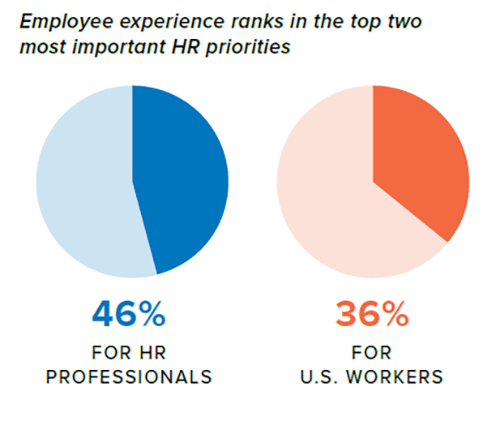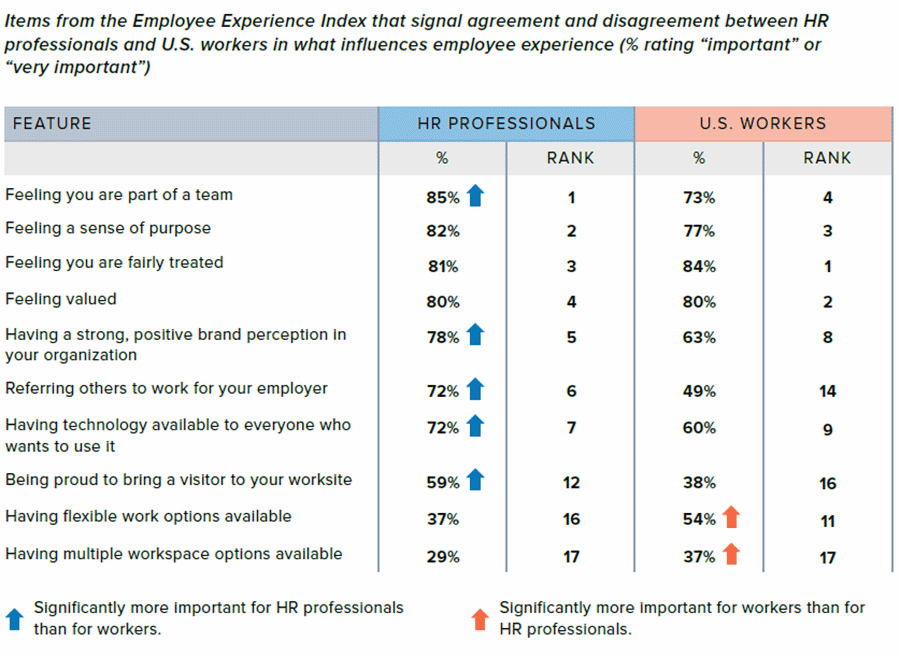What’s it like for employees to work at your organization? What’s their experience?
Along with employee engagement, employee experience is an important element that impacts hiring and retention, according to SHRM research released March 1. And it’s a vital HR function.
Employee experience is a concept that is “just catching on because employee satisfaction and employee engagement scales remain far more common ways to gather feedback from workers,” SHRM senior researcher Kristina Meacham writes in SHRM’s report, called The Case for Employee Experience.
SHRM’s survey in February of 1,197 HR professionals and 1,206 U.S. workers found that among a list of 12 responsibilities of HR departments, both groups said “creating a positive employee experience” was a foremost responsibility of HR departmental functions. In fact, 46 percent of HR professionals and 36 percent of workers ranked it as first or second in importance.

Additionally, 24 percent of HR departments use employee experience measures—such as employee pulse surveys or the Employee Experience Index from Jacob Morgan—and they reported improvements in their company culture, employee engagement, collaboration and retention.
But if HR professionals wonder if they should measure employee experience instead of engagement, neither yardstick “seems to be a better measure than the other,” Meacham noted.
“Instead, they are like looking through different lenses at the same issue. Monitoring both together seems to take a more complete snapshot of the workplace environment than either does alone.”
In fact, “when employee experience and employee engagement are measured together, organizations can explain 54 percent of employees’ job satisfaction levels and 42 percent of their desire to quit,” SHRM found.
Defining Employee Experience
How the employee experience is viewed depends, in some part, on whether you are an HR professional or non-HR employee, according to the findings. For non-HR workers, interactions with co-workers and supervisors shape their employee experience, while HR professionals tend to see the employee experience in terms of the actions of their organization’s top leaders and company culture.
Both HR and other workers agreed the following were the top elements contributing to the employee experience, even as they ranked them differently in importance:

“SHRM is passionate about improving the world of work through its timely workplace research and thought leadership,” said Johnny C. Taylor, Jr., SHRM-SCP, SHRM president and CEO. “The Case for Employee Experience highlights the key role that positive work culture has in reducing turnover and increasing productivity. As SHRM observes Employee Appreciation Day, we encourage organizations to consider what this concept means to their employees and use that information to benefit all members of their workplaces.”
Measuring Employee Experience
SHRM offered the following recommendations for measuring employee experience:
- Gather internal stakeholders to define what a positive employee experience means for your organization. For example, flexible schedules might be more critical at a manufacturing firm, while autonomy might be most important at a tech company.
- Communicate the definition of employee experience and how employees are expected to contribute. Include this in a variety of materials—the employee handbook, job descriptions, training materials, and through other means such as employee committees.
- Use manager training programs to highlight the impact of leadership styles on the employee experience for team members.
- Incorporate informal employee feedback, such as casual conversations or employee listening sessions with a trained facilitator. Invite employees to propose and undertake fixed-term projects to address any issues that are uncovered.
- Consider frequent, brief pulse check-ins rather than a massive annual survey. Avoid “survey fatigue” by focusing on aspects most important to employees at your organization. Then, share the results in a productive and timely manner.
- Design onboarding and offboarding experiences with your organization’s definition of a positive employee experience in mind.
- Use exit interviews to learn about the employee’s experience and how poor experiences might be corrected going forward.
“Every member of an organization shapes employee experience,” the SHRM researchers pointed out. For example, top leadership should demonstrate consistent behaviors that shape their organization’s culture and allocate resources to address negative issues uncovered in employee surveys.
“However, HR departments have the most direct impact on overall employee relations. HR departments must take ownership of and thoughtfully cultivate employee experience. Doing so will promote positive organizational outcomes,” Meacham wrote.
“There are a number of aspects of employee experience that we as HR professionals can and should be attending to. For all aspects that the organization has the power to improve, HR should be staunch advocates for those change efforts.”
An organization run by AI is not a futuristic concept. Such technology is already a part of many workplaces and will continue to shape the labor market and HR. Here's how employers and employees can successfully manage generative AI and other AI-powered systems.




